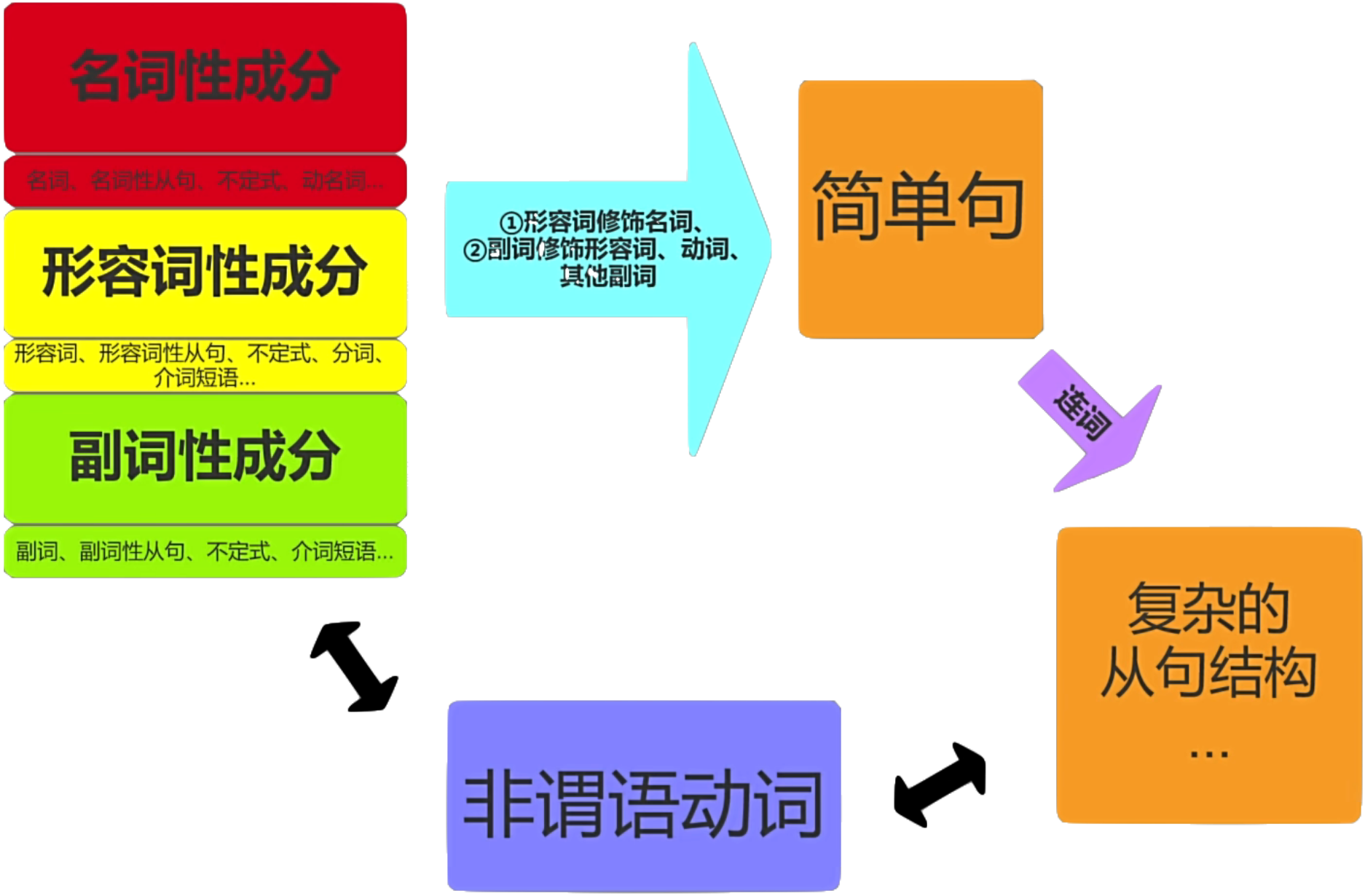英语语法

1. 词性
换一种方式理解词性
1.1. 名词、形容词和副词
名词性成分、形容词性成分、副词性成分,这就是一切!整个英语语法的核心就是这三种词性成分。这是一切语法的起点,见上面的英语语法框架图。
- 名词性成分包含:名词、名词性从句、不定式、动名词
- 形容词成分包含:形容词、形容词性从句、不定式、分词、介词短语
- 副词性成分包含:副词、副词性从句、不定式、介词短语
英语语法学的好不好,以新概念三的第一篇课文为例,能够把整个文章标出三种颜色(三种词性),就算过关。
11 种常用词性
- 名词(Noun)
- 动词(Verb)
- 形容词(Adjective)
- 副词(Adverb)
- 代词(Pronoun)
- 介词(Preposition)
- 连词(Conjunction)
- 感叹词(Interjection)
- 冠词(Article)
- 数词(Numeral)
- 限定词(Determiner)(some, any...)
这 11 种常用词性,最终会划分成三大类:名词性成分、形容词性成分和副词性成分
1.2. 词性的修饰关系
英语和汉语的区别。
- 英语是树形结构,汉语是竹形结构。
- 汉语的语法宽松,自由度比较高,一节一节的说下去就行,组织结构没有那么严密。
- 英语的结构更复杂一些,它的语法结构比汉语更严格,更有组织性。
写英语文章容易犯的问题,就是一逗到底或者 and,就是在用竹形结构写英语。
形容词性成分修饰名词性成分
The beautiful flowers have a sweet fragrance.
副词性成分修饰形容词性成分、动词和其他副词性成分
Her performance was surprisingly good.
- He runs slowly.
She speaks very softly.
形容词性成分修饰名词性成分:定语
- The beautiful flowers have a sweet fragrance.(形容词)
- The flowers which are stolen from Michael have a sweet fragrance.(形容词性从句)
- The flower stolen from Michael have a sweet fragrance.(分词)
- 副词性成分修饰形容词性成分:状语
- Her performance was surprisingly good.(副词)
- Her performance was good when her mom is around.(副词性从句)(状语从句)
- 副词性成分修饰动词状语
- He runs slowly.(副词)
- He runs if he is fillowed.(副词性从句)
- 副词性成分修饰其他副词成分状语
- She speaks very softly.(副词)
- She speaks like a gun.(副词性介词短语)
1.3. 介词其实很简单
介词=形容词or副词
THe puma is up a tree.【介词】
He looked up.【副词】
Prices(价格.n) are up.【形容词】
It depends on what they do.【介词】
The car stopped and then drove on.【副词】
The TV(.n) is on.【形容词】
介词只有一种用法:介词+名词性成分=介词短语
- The cat on the table is named Floppy.【名词短语】
- He walked though the park.【名词短语】
- She apologized for arriving late to the meeting.【分词短语】
She's not certain about whether she'll go to the party or not.【名词性从句】
形容词属性的介词短语
形容词属性的介词短语一般用作后置定语,用来修饰名词
- The book on the shelf is great.(后置定语)
I have the hot summers in Changsha.(后置定语)
副词属性的介词短语
副词属性的介词短语用于修饰动词、形容词、以及其他副词
- 修饰动词
- We went to a movie after dinner.
They have classes at our local school.
修饰形容词
- I am ready for dinner.
Sally is happy with her new teacher.
修饰其他副词
- We got there late in the evening.
- Our team scored early in the first quarter.
介词
- 简单介词:as,at,by,during,with...
- 分词介词:considing,including,given,granted...
- 短语介词:ahead of,next to,because of,owning to,along with,as well as,in case of,in change of,in common with,as a result of,in the absence of,to the best of,with an eye to...
2. 简单句
理解了简单句,你就理解了一切。
2.1. 主谓宾定状补
- 主语(Subject) (名词属性)
- 谓语(Predicatr)(名词属性)
- 宾语(Object)(名词属性)
- 定语(Attributive)(形容词属性)
- 状语(Adverbial)(副词属性)
- 补语(Complement)(形容词、名词属性)
2.2. 简单句的构成
2.3. 语法分析实践(1)
3. 从句
从句 = 连词 + 简单句 从句是简单句的嵌套
3.1. 并列句
并列句 = 简单句 + 简单句,必须有连词
3.2. 名词性从句
3.3. 形容词性从句
也叫定语从句。
3.4. 副词性从句
也叫状语从句。
4. 非谓语动词
非谓语动词和从句时一回事,非谓语动词和从句可以互相转换。